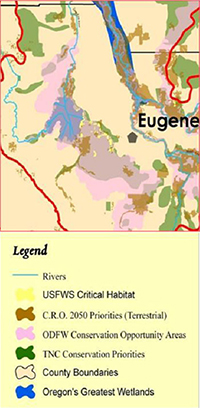Using the Eco-Logical Approach to Develop and Implement Conservation and Mitigation Priorities for Oregon

Integrated conservation priorities in the Willamette Basin. (Courtesy of
OSU)
Oregon State University
| Total cost: |
$101,552 |
| FHWA share: |
$49,962 |
| Period of performance: |
20 months |
| Dates: |
June 11, 2008 – February 11, 2010 |
| Status: |
Complete |
| AOTR: |
Michael Lamprecht |
| Grant-project website: |
https://ib.oregonstate.edu/research/ecology |
Project Goals
Two project goals of the Oregon State University (OSU) Eco-Logical grant were to identify Oregon’s conservation priority areas and to consolidate disparate data from each area into an online Regional Ecosystem Framework (REF) tool (see footnote on page 28). The project built on the Oregon Conservation Strategy, developed by the Oregon Department of Fish and Wildlife, and the Comprehensive Mitigation/Conservation Strategy, prepared by the Oregon Department of Transportation (ODOT).
Project Accomplishments
The REF helps agencies throughout the State plan for mitigation and conservation projects associated with transportation projects; the online tool characterizes projects relative to conservation priority areas. OSU completed a pilot study to apply the online tool to the Willamette Valley, where the region’s two MPOs began to use the REF to inform their planning activities. The U.S. Environmental Protection Agency (EPA); Oregon Department of State Lands (DSL), the State wetlands agency; and Oregon Department of Environmental Quality informally agreed to adopt OSU’s methods to identify and implement important wetland mitigation sites. Additionally, OSU helped DSL to develop a wetlands database based on REF data; DSL has since used this database to guide its mitigation planning and implementation efforts. OSU also assisted the U.S. Fish and Wildlife Service (FWS) in determining areas to avoid for bridge projects to complement ODOT’s Bridge Delivery Program and then applied the project methodology to develop endangered species maps for FWS. As part of the effort, OSU provided environmental data to ODOT staff. Data from OSU’s Eco-Logical grant project has also helped to develop The Intertwine, a conservation strategy that identifies priority areas for preservation in the Portland-Vancouver metro area. At the MPO level, OSU has worked with three MPOs (Metro, Lane Council of Governments, and Rogue Valley Council of Governments [RVCOG]) to apply the Eco-Logical tool to their planning activities. RVCOG, one of OSU’s pilots for its REF, participated in a pilot project through the Capacity program of the Second Strategic Highway Research Program (C21) that focuses on innovative ways to integrate environmental data into the transportation planning process in southwestern Oregon.
Future Steps
OSU is working with ODOT, The Wetlands Conservancy, and DSL to catalogue potential and existing mitigation sites in Oregon. OSU has also received additional funding from EPA and The Wetlands Conservancy to complete a State wetlands database and is coordinating with FWS, DSL and, EPA staff to use spatial data to identify and attribute wetland quality.
Insights on Eco-Logical
OSU noted that much of the success in promoting the Eco-Logical approach comes from leadership support, which includes support from the Governor and leaders at ODOT. Stakeholder buy-in helped OSU to update and expand on the data and applications of its REF. OSU observed that many agencies in Oregon produce plans independently, often hiring consultants and focusing on a specific plan application. These agencies have expressed reluctance to share data or to forego their independent plans in favor of a plan with broader goals. OSU is working to communicate that joint planning can save time and money, while still meeting the agencies’ goals. OSU’s Eco-Logical grant project also demonstrated to ODOT and other State agencies that the Eco-Logical approach is similar to a programmatic agreement in that it streamlines communications and project reviews between environmental and transportation agencies.
<< Return to Grant Projects

